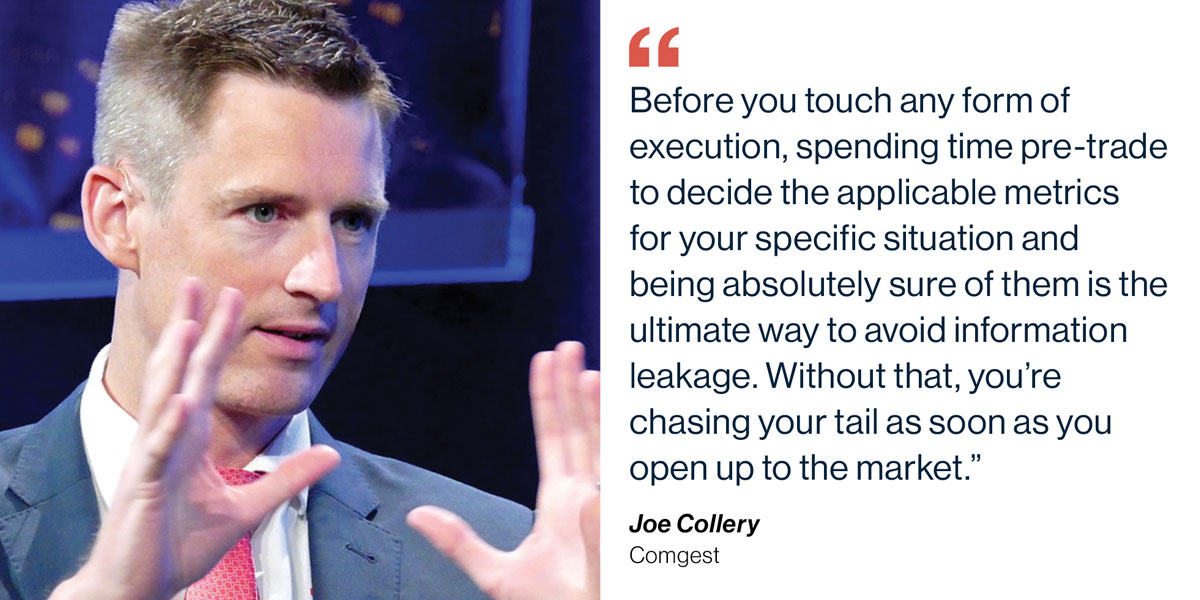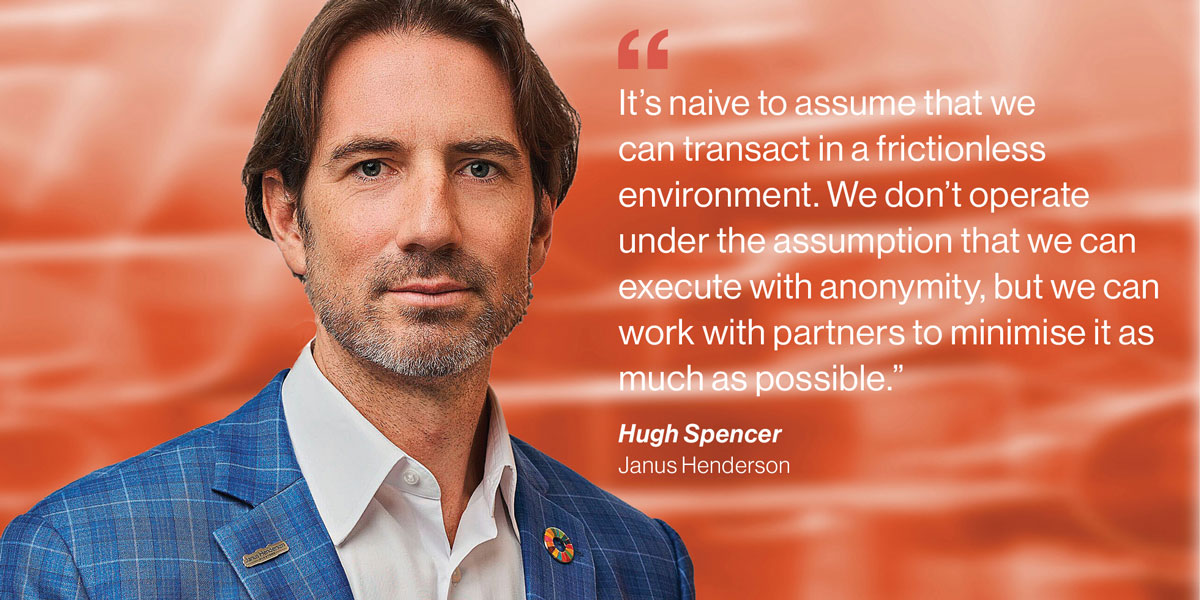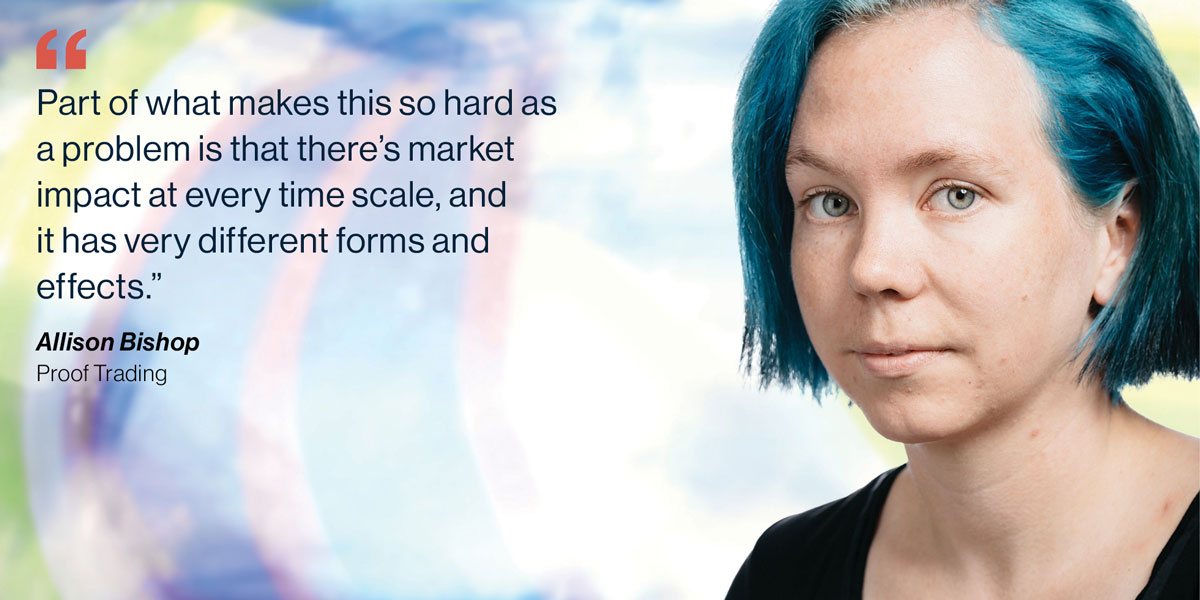 Information leakage is an unwelcome constant in trading, with traders adopting various forms of subterfuge to prevent competitors catching wind of their actions and taking advantage of their plays. As new tactics gain popularity and the buy side tries to get ahead of frontrunning competitors, the question of which strategy to lead with is more pressing than ever. Lucy Carter reports.
Information leakage is an unwelcome constant in trading, with traders adopting various forms of subterfuge to prevent competitors catching wind of their actions and taking advantage of their plays. As new tactics gain popularity and the buy side tries to get ahead of frontrunning competitors, the question of which strategy to lead with is more pressing than ever. Lucy Carter reports.
Trading is getting faster. The increases in high-frequency, algo and automated trading mean that buy-side market participants are even more acutely aware of market movements. The smallest blip could alert others to market activity, opening them up to adverse behaviour from rivals.
“Information leakage, also called signalling effect, is not talked about enough. It’s a question of education from the trading side and also from clients, because the end impact can be material,” says a senior trader at a large French buy-side firm. “When traders’ behaviour is too aggressive in the market, they create a lot of information and this is used to compete with their own execution.”
No trader wants to admit experiencing information leakage, because it is tantamount to admitting poor performance. A fund that was hit with information leakage would have poor returns because the stocks it wanted to buy would become expensive and those it wanted to sell would fall in price. According to a 2023 study by BlackRock, the information leakage impact of submitting requests-for-quotes (RFQs) to multiple ETF liquidity providers could be as much as 0.73%, amounting to a significant trading cost.
Unavoidable
“It would be impossible to have zero information leakage,” states Hugh Spencer, global head of equity trading at Janus Henderson. “It’s naive to assume that we can transact in a frictionless environment. We don’t operate under the assumption that we can execute with anonymity, but we can work with partners to minimise it as much as possible.”
“Part of what makes this so hard as a problem is that there’s market impact at every time scale, and it has very different forms and effects,” explains Allison Bishop, president and co-founder of execution-only broker-dealer Proof Trading. The company provides algorithms for institutional US equity asset managers, with a focus on improving market transparency and identifying bad broker-dealer practices. “Exchanges have a lot of control over how people interact with their market at the level of microseconds and milliseconds, and are creating tools to promote atomic operations, and facilitate instant, non-intermediated trading. These have been widely adopted and very successful.”
However, “exchanges are also pushing things like extended trading hours, which are very bad for information leakage,” Bishop continues. “I expect 24/7 trading would be a disaster from both an information leakage and a market impact perspective. Whether trading on lit exchanges or in dark pools, people have to find each other by being willing to trade in the same place at the same time. The more surface area that people have to try to traverse to do that in terms of time and space, the more they’ll interact with market makers. That gives market makers more information.”
The trader’s toolbox
Impossible to stop, but possible to reduce. Traders are employing a number of tactics to cut down how much information makes it out into the market, and always looking for different ways to keep their cards to their chests – whether through in-house or outsourced solutions.
“We need to find different solutions or execution protocols to be competitive and reduce trade information leakage,” the French buyside trader affirms. “We need to be reviewing our IT and technology stack to be sure that our trading system can address and leverage all the new analytics needed to guarantee that information leakage is taken into consideration.”

It is important to begin at the beginning – or before it. To minimise information leakage, extensive preparations must be undertaken before the trade itself can take place, advises Joe Collery, head of trading at US$33 billion active fund Comgest. “Before you touch any form of execution, spending time pre-trade to decide the applicable metrics for your specific situation and being absolutely sure of them is the ultimate way to avoid information leakage. Without that, you’re chasing your tail as soon as you open up to the market.”
“From experience, [it’s important to] put those factors together, both internal historical metrics in conjunction with real time market analytics to come up with your strategy, do everything you can before you step into the market. Because once you’re on, it’s open.”
The upcoming consolidated tape in Europe and the UK will help here, he predicts, “adding a little bit of much needed pre-trade colour and cost consolidation”.
The French senior buyside trader agrees that pre-trade optimisation is crucial; “we need to be sure that we have enough real-time information to demonstrate that we have achieved the best price,” he explains, “and that’s a challenge.”
On the ground
When it comes to the trade itself, one of the most popular methods to limit information leakage is randomisation. Traders gather a pool of algorithms and allocate trades to them on an unbiased basis, a tactic sometimes referred to as an algo wheel. By doing so, traders aim to make their actions look as random as possible, hoping that predators won’t find patterns and take advantage.
At Janus Henderson, new algos are introduced and tested in small sample sizes in order to keep up with product innovation. “We run a test environment on our EMS parallel to our production environment. When we have success here we look to introduce A/B testing with newly created algorithmic solutions in a very controlled manner in our production environment. Based on the results of this testing versus the hypothesised objective of the algorithm, we move to roll this into larger scale application,” Spencer shares.

In order for any of these tools to work, “you have to have a large enough subset who are willing to be innovative. You need asset managers to be willing to avail themselves of new solutions,” Spencer notes.
A partnership model is prioritised at Janus Henderson, he explains. “It’s a very competitive environment. Brokers are willing to invest in their platforms and individuals to make sure they have the best of breed. Availing ourselves of that technology and innovation on a broader spectrum, opposed to a more myopic, isolated in-house approach, has been beneficial.”
“We work closely with quantitative specialists and algorithm architects to curate our automated and selective customised electronic execution toolset. We take advice on the tactical construction of the algorithms we use, whilst also providing direct feedback to our partners on how they can improve on execution-related client outcomes and customer service. We believe this creates broader benefit for ourselves, our broker partners, and other clients seeking improvement of execution.”
Another tool taking off is trajectory crossing, already a popular solution in the US and now making its way into Europe. Nasdaq is the latest to offer the service, launching a European companion to its North American PureStream product. A representative told Global Trading earlier this year that demand for trajectory crossing was growing in the region in tandem with the increasing number of providers on the market.

With these tools, “the dream scenario is that you have two institutions, one wants to buy and one wants to sell, and they find each other in a trajectory cross at a big size. That shouldn’t move the market, they’re evenly matched and they’ll march along with the market at volume-weighted average price (VWAP),” Bishop says. “These kinds of order types and exchange products are designed to facilitate an ideal but tools can be used in different ways. How can people interact with it in ways that might gain them information?” Providers may ban participants who repeatedly use their platforms to sound out the market and drop out once they know there’s liquidity out there, but it’s inevitable that attempts will be made to game the system.
Bishop suggests that changes need to be made to behaviour rather than mechanics. “I don’t know that there’s any holistic solution to matching institutions over the fuller trading day, except the very simple, low effort solution: compressed trading and being more patient.”
Collery is confident that trajectory crossing will gain the same acclaim it has in the States, but believes that the demand for such a service is indicative of a broader problem. “Unfortunately, with the proliferation of passive investing, these standard benchmarks are just, ‘I just need the close, I just need the VWAP’. It’s making it difficult for anybody who wants to be invested in a company because it’s something they believe in, something that’s going to return the kind of growth and performance that they want.” People are too focused on benchmarks, he argues, tracking basket indexes and making sure to get in at the close rather than taking a longer term view. Passive investing is one way to reduce the information leakage problem, as trades are made based on benchmark index changes – which are public information.
However, the longer-term impact of this behavioural shift could be damaging to overall market health. “These products are fulfilling a need, but the more you fulfil that need the more liquidity you take out of the normal market and inhibit accurate price formation,” Collery says. “Will all significant market participants have to move to trade certain names at the close exclusively? I hope not.”
The bright side
While broadly seen as a negative, in some cases information leakage can be a valuable tactic. “Certain liquidity venues and market participants that can provide liquidity come with the cost of providing them information,” explains Henderson. “Depending on the urgency behind deploying an investment decision, it can be necessary.”
“It can be tolerable in certain strategies or investment solutions. If you’re looking to enter a stock in a very rapid manner or exit a stock due to cash flow constraints or a desire to no longer hold that position, you will tolerate a certain amount of information leakage to reduce execution risk.”
Expectations of information leakage differ across markets. “The developed ones have improved so much, and provided the trader has taken the time to come up with a strategy, it can be minimised” says Collery. “In other markets, where there are premiums to be paid, checks to be made to ensure that cash is on account before you trade, where there are foreign ownership level limits; there’s a lot more complexity there.”
Losing liquidity
Some traders see the lit market as the enemy, believing that the best way to avoid information leakage is to opt out of them as much as possible. That’s where dark venues come in, allowing trades to be matched without anyone knowing.
“We combine passive activities and liquidity synching before going to the lit markets because we know that information leakage could be more pronounced there,” the senior French buyside trader confirms. This increased use of dark pools is helpful in the short term, but as more migrate to such services, the amount of liquidity openly accessible to traders is dwindling.
As new trading strategies are adopted to reduce information leakage, there is potential for that liquidity squeeze to worsen. As the market evolves it creates new problems for itself, necessitating subsequent solutions – and so the cycle continues.
©Markets Media Europe 2025

 Information leakage is an unwelcome constant in trading, with traders adopting various forms of subterfuge to prevent competitors catching wind of their actions and taking advantage of their plays. As new tactics gain popularity and the buy side tries to get ahead of frontrunning competitors, the question of which strategy to lead with is more pressing than ever. Lucy Carter reports.
Information leakage is an unwelcome constant in trading, with traders adopting various forms of subterfuge to prevent competitors catching wind of their actions and taking advantage of their plays. As new tactics gain popularity and the buy side tries to get ahead of frontrunning competitors, the question of which strategy to lead with is more pressing than ever. Lucy Carter reports.